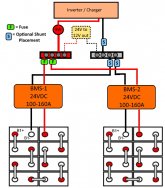Simply put, if you place say 4 cells in parallel, those 4 cells act like one (as far as a BMS is concerned) and therefore it can only read the "Average" of the 4 cells. Unless you have exactly perfect Matched & Batched Cells problems will arise, especially with higher capacity cells.
If the cells in the parallel set are at 2.75V, 3.00, 2.90, 3.00 the BMS will see 2.915V
0% SOC = 2.5V, 100% SOC = 3.65V
The real bugger is the Internal Resistance of the cells. Fully Matched & Batched cells have identical IR through the voltage ranges but regular Commodity Cells which are only Voltage & Base IR Matched the IR's will vary across the voltage ranges. The IR affects how fast a particular cell can Charge/Discharge. When cells are paralleled without being fully matched, they can diverge further between themselves if their IR varies too much, and so as some cells reach 100% SOC, the lower cells will still be demanding more, in parallel, they "should" pull from the other sets in parallel but this doesn't quite work out for the BMS, because it can only see the "average".
Matching & Batching os cells is a long tedious process which get's longer with the bigger cells. Cells are mounted to a "rig", charged fully and then discharged at various rates with the IR being read at the set points, the cells are taken down to 0-SOC and then recharged, while also testing the IR at the set points. This cycle is usually repeated 3 Times with all the data being recorded & logged. Then cells which have matching IR through the voltage ranges get sorted & batched together. This process can add $50 a cell or more even and that adds up fast.
Case in Point: Battleborn, Relion, Fullriver, Trojan, Rolls Surette, Victron and ALL the High Quality Drop-In or ESS Battery systems are Matched & Batched Cells and THAT is one reason they cost so much more.... EV (Electric Vehicle) batteries are ALL Matched & Batched - THEY HAVE TO BE as Pack Consistency is critical, especially with High Demand battery systems. Yet another reason why EV Battery Packs are co expensive BUT it's als a warning about used EV Packs as often they may have one or more weak / bad cells within and were warranty pulled (EV makers do not repair EV packs, they just Re & Re them).




